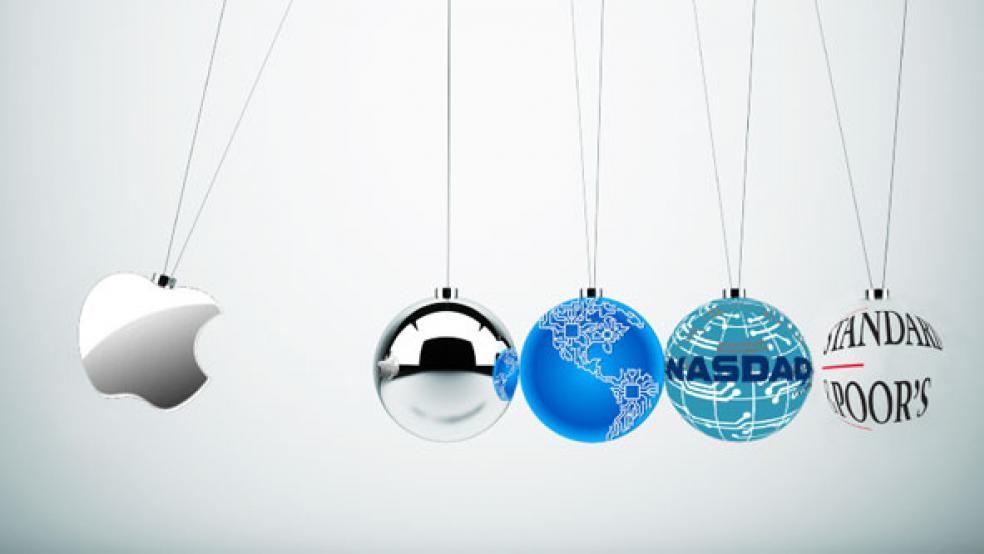The manic swings in Apple (AAPL) shares lately are leaving investors reeling. Down $17, down $25, up $30, down $21. Even for a stock that’s seesawing around $600 a share, those point swings have been substantial: Down 2.8 percent, down 4.1 percent, up 5 percent, down 3.5 percent. In all, Apple stock has lost nearly 9 percent from its 52-week high of $644.
What in the name of Tim Cook is going on?
The answer is all the more important because of the tremendous sway Apple holds on the stock market – and particularly, on the technology sector. In order to outperform the broad market index during the first quarter of 2012, an investor pretty much had to own stock in Apple; during that period, when the S&P climbed 12 percent, Apple’s shares soared nearly 50 percent. Apple now accounts for 4.5 percent of the market-cap weighted S&P 500 index – the largest percentage since Microsoft dominated the tech landscape in the late 1990s, as Reuters reported yesterday.
RELATED: Scrutiny and Lawsuits Nibble Away at Apple
The stock swings have come as Apple gets set to report its second-quarter earnings on Tuesday. Here, again, Apple is the corporate world’s 800-pound gorilla. As Reuters reported, without Apple the technology sector of the S&P 500 would report flat first quarter earnings over year-ago levels; adding Apple to the mix likelytranslates into a 7.9 percent gain in first-quarter profits for the sector. When it comes to the S&P 500 index, Apple’s results likelyboost profit growth for the first quarter by some 50 percent.
So as they prepare for Apple’s update next week, investors are doing their best to gauge whether the company’s results, both for the quarter and beyond, merit the huge run-up the stock has had since the beginning of the year. So far, Wall Street analysts still like the numbers they’re modeling. Apple has posted profit gains of more than 50 percent for eight quarters running – and seems poised to do it again for the three months that ended March 31. As has become traditional, analysts have been raising their estimates for Apple’s earnings steadily since its last big positive surprise a quarter ago.
As reported yesterday by AlphaNow, a website that is home to Thomson Reuters’ analytical content, while only a single analyst has cut his estimate for the March 31 quarter results since January, no fewer than 38 others have raised theirs.
Yesterday, Bill Shope at Goldman Sachs became the latest to jump on the bandwagon, calling for the company to earn $10.18 a share for the quarter, compared to a consensus estimate of $9.98. (The consensus has climbed 4 cents in the last 24 hours alone.) Odds are high that the company will beat that consensus and report earnings north of $10 a share.
The good news is that, despite the recent weakness, there seem to be few – if any – fundamental reasons why Apple’s shares should succumb to massive selling pressure right now. The company sold 37 million iPhones in the fourth quarter, up from 16 million the previous year; iPad sales skyrocketed to 15.4 million units from 7.3 million in the prior year’s fourth quarter. Goldman’s Shope is expecting Apple to report it shipped at least 31 million iPhones and 12.5 million iPads in the most recent quarter. As for the third quarter, ending June 30, Shope calls it “the beginning of a very big year” that will see iPhone and iPad owners upgrade or “refresh” their devices.
RELATED: iChildren: How Apple Is Changing Kids' Brains
At its current price, Apple’s stock is significantly below Shope’s target of $750 a share and even further away from the $857.50 level that Thomson Reuters’s StarMine Intrinsic Value model calculates to be its fair value. (The latter calculation assumes a forward 10-year growth rate of about 13.8 percent.)
There is other evidence that Apple’s shares – however astonishing their gains of recent months – remain fairly valued to slightly undervalued. A decade ago, Apple’s price/earnings ratio was double that of the S&P 500; by 2003, when the S&P traded for less than 20 times forward 12-month earnings, Apple commanded four times that level. Today, with the S&P at around 12.5 times earnings, Apple’s shares are valued at a modest 12.6 times earnings. The gains in the stock market have been impressive, but they have been greatly outpaced by the company’s rate of earnings growth.
Ironically, the biggest risk facing Apple and its growing legion of fans is that it has been too successful and become too large. Investment managers whose Apple holdings once amounted to a few percentage points of their portfolios are now watching uneasily as that weighting climbs steadily higher. Normally, when that happens, managers lighten up their holdings. But it’s hard to do that when the most attractive stock around – as some admit, ruefully – remains Apple. If it didn’t already make up 7 percent or 10 percent of their portfolio, it would be their first choice to buy, some say. To the extent that portfolio risk rules require them to lighten up on Apple, one says he will be settling for “second best.”
Could Apple run out of new investors? Even if the fundamentals support a still-higher share price and valuation, where will the fresh buying coming from to drive the stock price higher? It’s not impossible that considerations like that could put a cap on Apple’s upward momentum, or at least make the climb higher much bumpier from here onward.
On the other hand, investors’ reluctance to lighten up their holdings could mean that there’s some downside protection in place; if Apple’s share price falls, no doubt some of them will step in as eager buyers once more. Even if you don’t want to own the stock yourself, you probably don’t want to bet against it as long as the world remains addicted to its electronic gadgetry.





